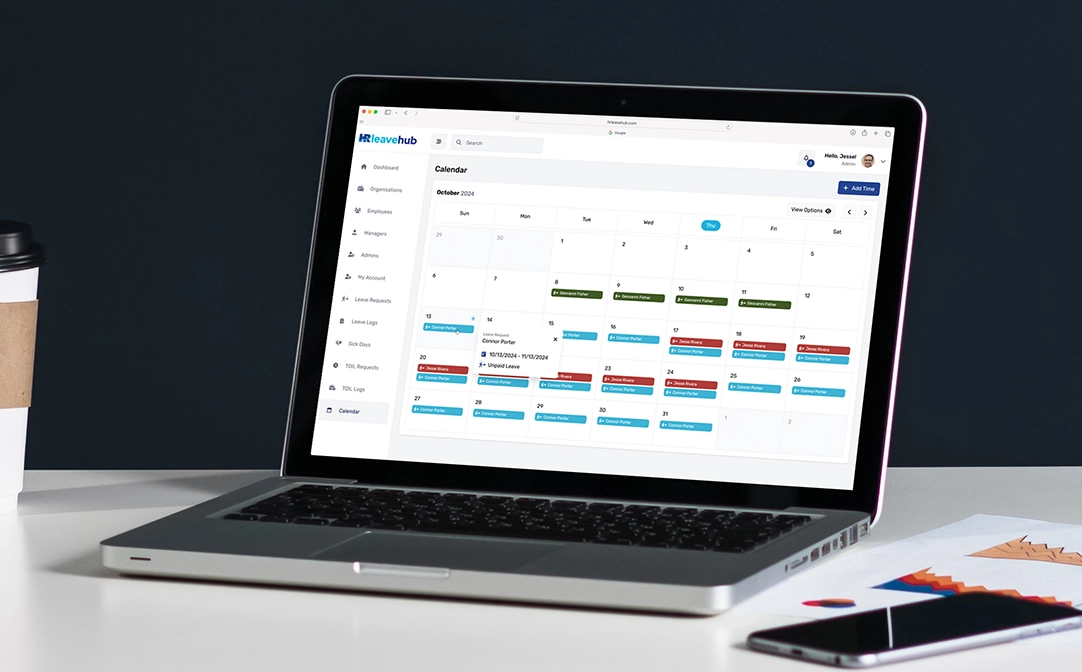Managing leave was once as easy as checking the wall calendar. But in 2025, with remote and hybrid teams spread across time zones and jurisdictions, that simplicity is gone. This article explains the legal, operational, and people challenges of managing leave and why software is the solution.
The Real Challenges of Leave Tracking for Remote and Hybrid Teams
Managing leave in distributed teams is no longer just an admin task but a daily coordination problem. Visibility gaps, time zone issues, inconsistent processes, and clashing schedules turn basic requests into operational risks. Here’s what employers need to understand.
Lack of Visibility and Poor Communication
Remote teams can’t see who’s on leave without a shared system. Spreadsheets and email chains hide crucial details, making coordination nearly impossible across time zones or departments.
Disconnected calendars and manual trackers lead to missed updates, overlapping leave, and short-notice absences. This weakens team planning and causes friction.
An employee leave tracker built for remote work provides real-time visibility for managers and staff. Unlike a leave tracking spreadsheet, software keeps everyone informed, regardless of their login location.
Time Zones and Scheduling Conflicts
Different time zones make coordination harder. A team member requesting leave in Dublin may unknowingly clash with another in London, creating unplanned coverage gaps.
Overlaps go unnoticed without a remote team calendar or centralised platform. Email threads and spreadsheet updates don’t sync across regions or departments.
Cross-border HR software UK-Ireland accounts for location-specific schedules. With automated alerts and real-time visibility, teams avoid conflicts and maintain smooth operations—even when spread across countries.
Inconsistent Approvals and Missed Policies
Leave requests come through emails, chats, or spreadsheets. Without a unified system, approvals get lost, delayed, or handled differently depending on the manager.
Policy enforcement is inconsistent across departments or locations. This leads to unfair treatment, confusion, and poor compliance with your remote team leave policy.
Modern HR software in the UK and Ireland standardises how leave is requested, approved, and recorded—so nothing is missed, and every employee is treated equally.
Legal Risks of Remote Work Leave Mismanagement
Whether your team works from Belfast, Dublin, London or abroad, you have legal obligations to meet. In 2025, the pressure is rising with new employment laws, leave types, and documentation requirements.
Different Public Holiday Rules
The UK and Ireland have different public holidays. A single policy doesn’t work across both jurisdictions, and applying the wrong one can lead to underpayment or legal exposure.
Remote workers are still entitled based on their local public holiday calendar. It doesn’t matter where the HR team is based.
An annual leave tracker with built-in UK and Ireland public holiday calendar logic ensures each employee gets the correct entitlements, without manual oversight.
Record-Keeping and New Legal Duties
UK law now requires leave records to be kept for six years. These records must show entitlement, usage, and carryover, especially during audits or tribunal cases.
In Ireland, employers must retain leave records for at least three years under the Working Time legislation. Manual tracking puts compliance at risk.
Leave documentation for the UK and Ireland is managed automatically with software. With built-in 2025 HR compliance features, employers stay audit-ready without chasing files or spreadsheets.
Distributed Contracts and Cross-Border Teams
Remote staff may work in different legal jurisdictions. A one-size-fits-all approach to leave policy no longer meets legal standards in 2025.
Leave rules must match local contracts and rights. Employers must apply the correct entitlements, public holidays, and leave types for each employee’s location.
Cross-border HR software UK-Ireland ensures jurisdiction-specific compliance. It applies the proper rules automatically, reducing legal risk and removing guesswork for HR.
Why 2025 Demands a Smarter Leave Management System
HR leaders can’t afford to manage distributed teams with outdated tools. 2025 is a turning point—remote work, AI, and legal reform have changed how leave must be tracked and reported.
Remote Work Is Here to Stay
A large portion of the UK and Irish workforce is now hybrid. As remote and flexible work becomes standard, leave management must evolve with it.
Manual leave tracking can’t keep up with distributed coordination. Email chains and spreadsheets create gaps that affect teams and service delivery.
A hybrid leave policy supported by software ensures visibility across all locations—whether staff work from home, the office, or abroad.
AI and Automation Expectations
AI and self-service drive HR tech in 2025. Managers and staff expect tools that reduce admin, not create more of it.
Automated leave trackers handle approvals, alerts, and policy enforcement without HR intervention. This reduces risk and increases response time.
HR software in the UK and Ireland now includes AI-powered logic that adapts to legal updates, contract types, and changing working patterns.
Employee Experience and Burnout Prevention
Poor tracking leads to underused leave and silent burnout. Employees don’t take time off if they can’t see what they’re owed.
Annual leave usage monitoring helps managers spot issues early and take action. Preventing burnout protects productivity and retention.
A transparent employee leave tracker builds trust and encourages regular, restorative time off.
Why Spreadsheets and Email Threads No Longer Work
Spreadsheets once worked. However, for remote teams, this now increases risk. Here’s why your spreadsheet can’t keep up, and what software does better.
Human Error and Delays
Manual leave entries are vulnerable to error—one wrong cell can miscalculate an entire team’s entitlements. Even basic approvals get delayed when they rely on emails or outdated calendars.
Remote leave approval becomes a guessing game without a centralised view. HR wastes hours fixing mistakes or resolving complaints.
A dedicated leave tracking software automates the process, applies rules accurately, and gives everyone real-time clarity. Errors drop, speed improves, and nobody is left waiting in an inbox.
Version Control and Data Security
Spreadsheets lack access control. They’re often saved in shared drives or emailed back and forth, with no guarantee you’re looking at the latest version.
There’s no audit trail, and no way to see who changed what. This creates risk when handling sensitive employee data or tracking leave records.
A secure employee leave tracker offers encrypted storage, permission settings, and full version history. Unlike spreadsheets, software meets modern GDPR standards and protects your people from accidental data exposure.
No Scalability or Real-Time Sync
Spreadsheets don’t scale. What works for a team of five becomes unmanageable at 25, and dangerous at 50 or more.
There’s no automatic update across departments. Teams operate from separate versions, creating confusion, missed leave, and poor coordination across regions.
Cloud-based leave software solves this. It updates instantly across all users, supports growth without added complexity, and ensures decisions are based on the same real-time data.
A modern employee leave tracker adapts to your structure, no matter how fast your team grows.
HR Leave Hub – The Best Leave Management Software for Remote Teams
HR Leave Hub was built for remote and hybrid teams in the UK and Ireland. It simplifies leave management, ensures compliance, and replaces spreadsheets with real-time, reliable software.
Designed for UK & Ireland Compliance
HR Leave Hub applies the correct public holiday calendars across NI, ROI, England, and Scotland automatically. It supports all statutory leave types, including annual leave, sick leave, parental leave, and other statutory time off, applying the correct calculations by region.
Carryovers, pro-rata entitlements, and leave resets are built in. No manual updates. No risk of under-compliance.
It’s built by UK and Irish HR legal experts. That means complete peace of mind with every leave request.
Built-In Automation and Notifications
HR Leave Hub automates the entire leave process, allowing staff to request time off, managers to approve with one click, and everyone to stay informed.
Employees see their leave balance and status in real time. Managers get alerts for upcoming absences, conflicts, or staff underusing their entitlement.
Automation keeps everything moving without emails, reminders, or missed updates. You don’t just save time, you eliminate risk and admin headaches.
Perfect for Remote Teams
HR Leave Hub is cloud-based, secure, and accessible from any device. Whether your staff are in Cork, Manchester, or working remotely abroad, they log in and manage leave with ease.
It works on mobile and desktop—ideal for hybrid, field-based, or fully remote teams. Everyone stays aligned, even across time zones.
As your team grows or policies evolve, HR Leave Hub adapts. It scales with you, without the bloat or bottlenecks of legacy systems.
Final Thoughts – Software Over Spreadsheets in 2025
Managing leave across remote teams is no longer a task for spreadsheets. HR Leave Hub provides you with accuracy, visibility, and compliance, all without the admin headache.
Manual systems are unlikely to meet the demands of remote work in 2025. Legal compliance, employee wellbeing, and operational clarity all depend on more intelligent systems. HR Leave Hub provides leave management software that UK and Irish businesses can trust across borders and time zones.
Register for free and get a 14-day free trial of HR Leave Hub today.
FAQ – Leave Management for Remote Teams
What’s the best way to manage leave for remote teams?
Using leave management software for remote teams ensures real-time tracking, visibility, and compliance. Tools like HR Leave Hub help remote staff and managers coordinate time off easily across locations and time zones.
Do remote staff still receive public holidays?
Yes. Remote employees are entitled to public holidays based on their location, not the company HQ. HR Leave Hub applies the correct remote team leave policy using regional public holiday calendars.
Is there a legal duty to track leave for remote workers?
Yes. UK employers must keep leave records for six years; Ireland requires three. Employee leave trackers like HR Leave Hub automatically log, store, and protect these records for full compliance.
Can software prevent leave clashes in remote teams?
Yes. HR Leave Hub provides a shared calendar view with real-time updates, helping managers avoid overlap and ensuring coverage, critical for remote or hybrid teams.
Why switch from spreadsheets to HR Leave Hub?
Spreadsheets cause errors, delays, and poor visibility. HR Leave Hub replaces manual processes with automation, compliance tracking, and complete transparency across your remote workforce.



